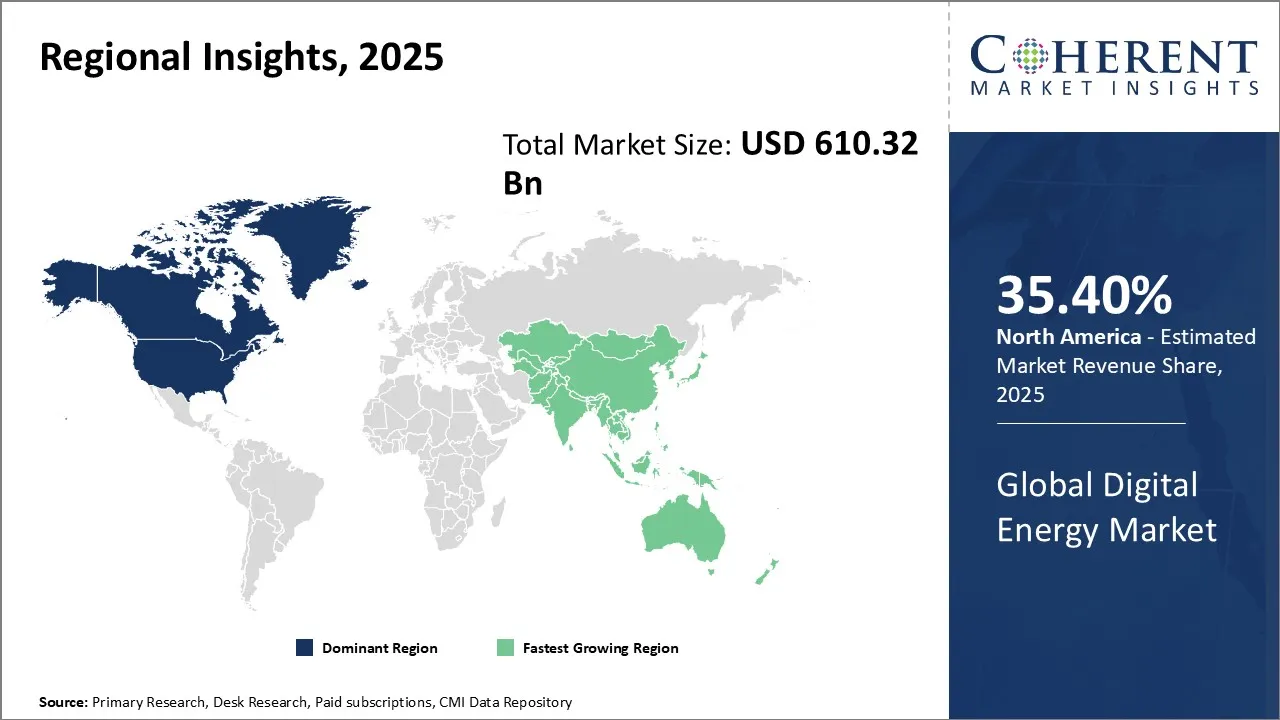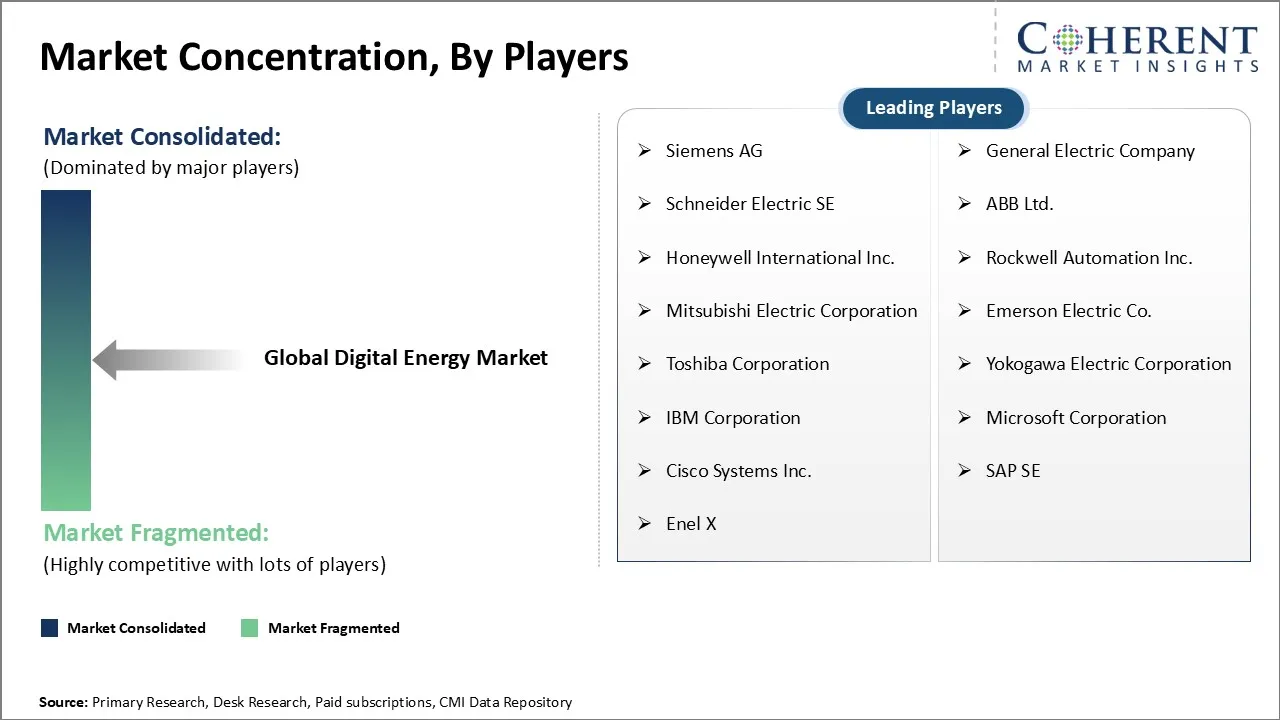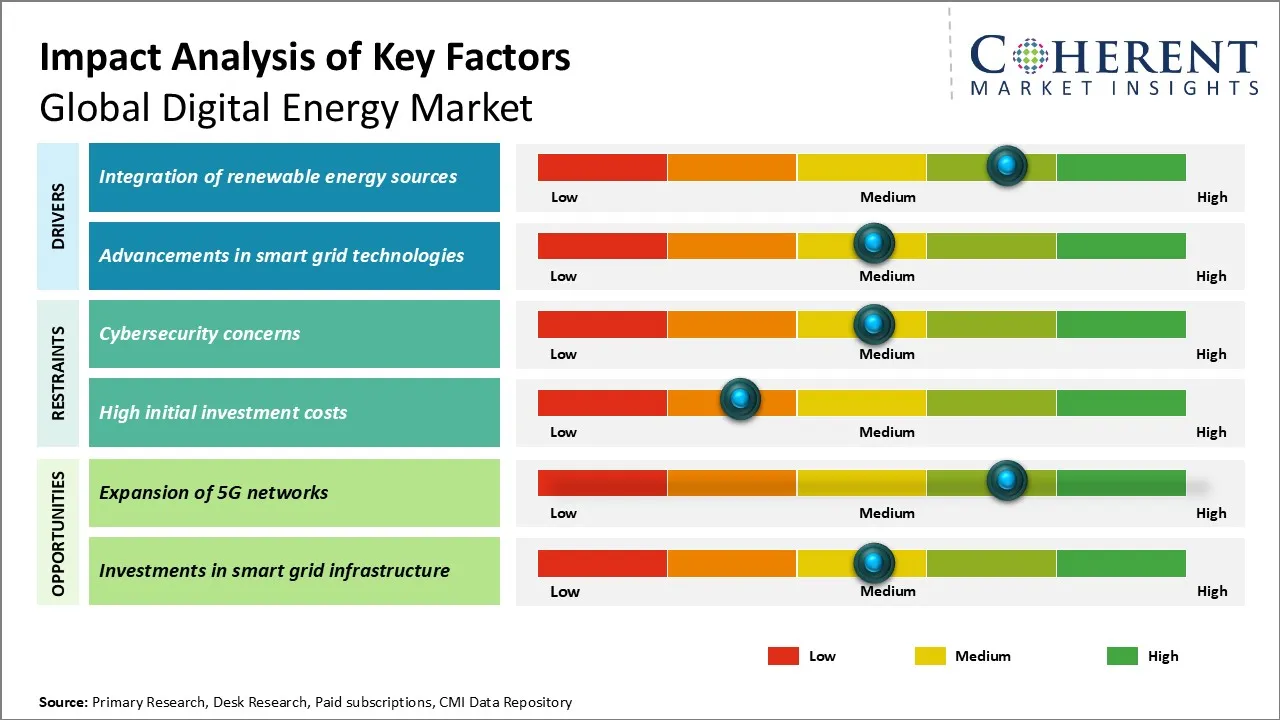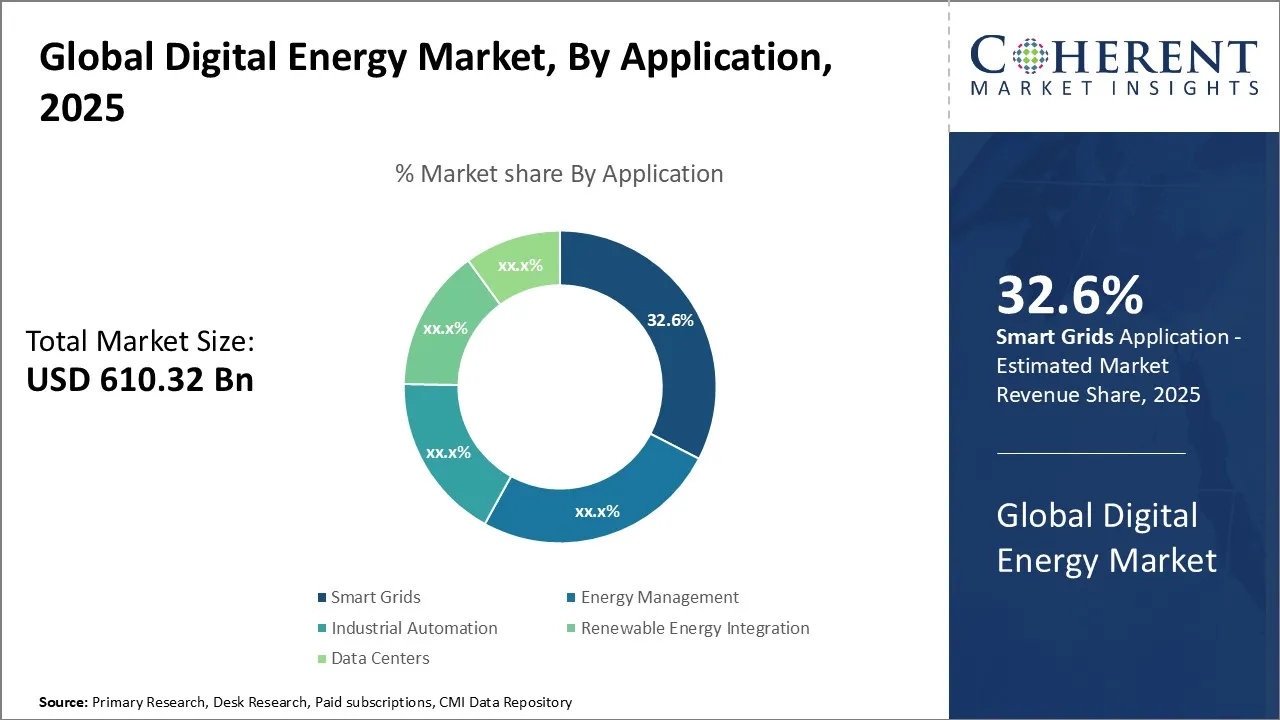Global Digital Energy Market Size and Forecast – 2025-2032
The Global Digital Energy Market is estimated to be valued at USD 610.32 billion in 2025 and is expected to reach USD 1,101.44 billion by 2032, exhibiting a compound annual growth rate (CAGR) of 8.8% from 2025 to 2032.
Key Takeaways of the Global Digital Energy Market:
- The smart grids segment leads the market holding an estimated share of 32. 6% in 2025.
- The Internet of Things (IoT) segment is projected to dominate with a share of 31. 4% in 2025.
- North America is estimated to lead the market with a share of 35. 4% in 2025.
- Asia Pacific, holding a share of 31. 2% in 2025, is projected to be the fastest growing region.
Market Overview:
The market trend for the digital energy market is characterized by the rapid integration of advanced technologies such as artificial intelligence, internet of things (IoT), and Blockchain. These technologies are enabling the development of smart grids, intelligent energy management systems, and decentralized energy solutions. Moreover, the growing emphasis on renewable energy sources and the transition towards a low-carbon economy are further fueling the demand for digital energy solutions.
Current Events and their Impact:
|
Current Events |
Description and its impact |
|
Global Renewable Energy and Sustainability Initiatives |
|
|
Shifting National Policies and Infrastructure Investments in Asia Pacific Region |
|
Uncover macros and micros vetted on 75+ parameters: Get instant access to report
Global Digital Energy Market Insights by Application – Smart Grids Lead as They Enable Efficient and Resilient Energy Distribution
In terms of application, the smart grids segment is expected to contribute the highest share of 32.6% in the global digital energy market in 2025. Smart grids leverage advanced digital technologies, such as sensors, meters, and communication networks, to monitor and optimize energy flow in real-time. This enables utility companies to reduce energy losses, minimize outages, and improve overall grid performance. Also, as countries focus on transitioning towards cleaner energy, the incorporation of solar, wind, and other renewable sources into the grid becomes crucial. Smart grids facilitate the seamless integration of these intermittent energy sources by providing the necessary infrastructure for bi-directional power flow and energy storage.
Governments and regulatory bodies worldwide are also actively promoting the deployment of smart grids through favorable policies and incentives. For example, the U.S. Department of Energy (DOE) offers the Smart Grid Investment Grant (SGIG) program under the American Recovery and Reinvestment Act (ARRA).
Global Digital Energy Market Insights by Technology – Internet of Things (IoT) Leads as it Enables Seamless Connectivity and Data-Driven Insights
In terms of technology, the Internet of Things (IoT) segment is expected to contribute the highest share of 31.4% in the global digital energy market in 2025. IoT-enabled devices, such as smart meters, thermostats, and energy management systems, allow for the collection of vast amounts of data related to energy consumption, production, and distribution. This data provides valuable insights into energy usage patterns, enabling utility companies to optimize their operations, reduce waste, and improve overall efficiency. Also, IoT sensors and communication networks enable the continuous monitoring of critical infrastructure, such as power plants, transmission lines, and substations.
Enel, a multinational energy company, has implemented one of the world’s largest IoT-based smart grid initiatives through its subsidiary e-distribuzione in Italy. This project involves the deployment of over 44 million smart meters and the digitization of the electricity distribution network using IoT-enabled devices and platforms.
Role of Artificial Intelligence (AI) in the Market:
Artificial Intelligence (AI) is playing a transformative role in the global digital energy market by enabling smarter, faster, and more adaptive energy systems. AI algorithms are used to analyze massive volumes of real-time data from IoT devices, smart meters, and grid infrastructure to forecast energy demand, optimize load balancing, and predict equipment failures before they occur. This predictive capability enhances grid reliability, reduces operational costs, and supports the integration of variable renewable energy sources like solar and wind. AI is also facilitating the development of autonomous energy systems, such as virtual power plants and decentralized grids, where distributed energy resources (DERs) are intelligently coordinated to respond to market signals and grid needs in real time.
An example is National Grid ESO’s partnership with Google DeepMind in the U.K. The collaboration leverages DeepMind’s machine learning models to forecast electricity demand and supply patterns with greater accuracy than traditional methods.
Regional Insights:

To learn more about this report, Download Free Sample
North America Digital Energy Market Analysis and Trends
North America, holding a share of 35.4% in 2025, is expected to dominate the global digital energy market. The region has a well-established market ecosystem, with a strong presence of major technology companies and energy providers. Its advanced infrastructure and high investment in research and development have further contributed to its dominance. Notable companies such as General Electric, Siemens, and Schneider Electric have played a significant role in driving the growth of the digital energy market in North America through their innovative solutions and services.
PG&E, one of the largest utilities in the U.S., has implemented a wide-scale smart grid modernization program aimed at enhancing grid resilience, reducing outages, and integrating renewables.
Asia Pacific Digital Energy Market Analysis and Trends
The Asia Pacific region, holding a share of 31.2% in 2025, is expected to exhibit the fastest growth in the global digital energy market. The region's rapid economic development, increasing urbanization, and rising energy demand have created a favorable environment for the adoption of digital technologies in the energy sector. Countries like China and India have made significant strides in implementing smart grid technologies and promoting renewable energy integration.
Companies like Huawei, Toshiba, and Hitachi have been actively involved in developing and implementing digital energy solutions in the region. CSPG is actively transforming China’s energy infrastructure with IoT-enabled smart substations, AI-driven grid controls, and 5G communication networks.
Global Digital Energy Market Outlook for Key Countries
U.S. Digital Energy Market Analysis and Trends
The U.S. digital energy market is characterized by a strong focus on grid modernization and the integration of renewable energy sources. Major players such as General Electric, Siemens, and Honeywell have been instrumental in driving the adoption of digital solutions in the U.S. energy sector. The U.S. government has also played a crucial role through initiatives like the Smart Grid Investment Grant program, which has supported the deployment of smart grid technologies nationwide.
China Digital Energy Market Analysis and Trends
China digital energy market has experienced rapid growth, driven by the country's ambitious renewable energy targets and the need for efficient energy management. The Chinese government has introduced policies and incentives to promote the adoption of digital technologies in the energy sector, such as the "Internet+" smart energy action plan. Chinese companies like Huawei and State Grid Corporation of China have been actively involved in the development and implementation of digital energy solutions, both domestically and internationally.
Germany Digital Energy Market Analysis and Trends
Germany has set ambitious targets for the transition to a low-carbon economy and has been investing heavily in digital technologies to support this transition. Germany has a well-developed smart grid infrastructure and has been at the forefront of implementing advanced metering systems and energy management solutions. Companies like Siemens and Bosch have been key players in the Germany digital energy market, offering innovative solutions for grid optimization and energy management.
India Digital Energy Market Analysis and Trends
India digital energy market is rapidly evolving, driven by the country's growing energy demand and the need for efficient energy management. The Indian government has launched several initiatives to promote the adoption of digital technologies in the energy sector, such as the National Smart Grid Mission and the Smart Cities Mission. Indian companies like Tata Power and Reliance Energy have been actively involved in the implementation of digital energy solutions, focusing on areas such as grid modernization and renewable energy integration.
Market Players, Key Players, and Competitive Intelligence:

To learn more about this report, Download Free Sample
Top Strategies Followed by Global Digital Energy Market Players
- Established players are investing heavily in R&D to develop cutting-edge technologies that can enhance energy efficiency, reduce costs, and improve overall performance.
- Siemens, a global technology powerhouse, has invested over USD 6 billion annually in R&D, including significant funding toward its “Smart Infrastructure” division.
- Mid-level players are focusing on delivering cost-effective solutions to target price-sensitive consumers. These companies are developing quality products that are affordable and accessible to a wider range of customers.
- Landis+Gyr, a Switzerland-based company, focuses on affordable smart metering and energy management for utilities, especially in cost-sensitive markets like Latin America and Southeast Asia.
- Small-scale players are targeting niche markets with unique features or innovative products. These companies are leveraging their expertise in specific areas to develop specialized solutions that cater to the specific needs of their customers.
- AutoGrid, a U.S.-based startup, specializes in AI-driven distributed energy resource management systems (DERMS) for microgrids and virtual power plants. The company deployed its Flex platform to manage community microgrids in Japan and the U.S.
Key Developments:
- In April 2025, PJM Interconnection, a regional transmission organization (RTO) in the U.S., announced a multiyear collaboration with Google and Tapestry to deploy AI-enhanced tools to further streamline PJM's planning process for connecting new generation resources to the nation's largest electrical grid.
- In April 2025, A.R.T. Digital Holdings Corp., a publicly traded Digital Energy company, and Plains Energy, an energy solutions and power production financing company, announced a strategic joint venture to accelerate the development of renewable-powered infrastructure to enhance renewable energy solutions.
- In March 2025, Schneider Electric, the global player engaged in the digital transformation of energy management and automation, is revolutionizing grid operations with its launch of the One Digital Grid Platform, an integrated and AI-powered platform designed to enhance grid resiliency, reliability and efficiency.
- In September 2024, The Digital Energy Solutions (DES) arm of Larsen & Toubro’s Power Transmission & Distribution (PT&D) business received the mandate to develop and implement energy management systems in regional and state load dispatch centers in South India.
Market Report Scope
Digital Energy Market Report Coverage
| Report Coverage | Details | ||
|---|---|---|---|
| Base Year: | 2024 | Market Size in 2025: | USD 610.32 Bn |
| Historical Data for: | 2020 To 2024 | Forecast Period: | 2025 To 2032 |
| Forecast Period 2025 to 2032 CAGR: | 8.8% | 2032 Value Projection: | USD 1,101.44 Bn |
| Geographies covered: |
|
||
| Segments covered: |
|
||
| Companies covered: |
Siemens AG, General Electric Company, Schneider Electric SE, ABB Ltd., Honeywell International Inc., Rockwell Automation Inc., Mitsubishi Electric Corporation, Emerson Electric Co., Toshiba Corporation, Yokogawa Electric Corporation, IBM Corporation, Microsoft Corporation, Cisco Systems Inc., SAP SE, and Enel X |
||
| Growth Drivers: |
|
||
| Restraints & Challenges: |
|
||
Uncover macros and micros vetted on 75+ parameters: Get instant access to report
Market Dynamics

To learn more about this report, Download Free Sample
Global Digital Energy Market Driver - Integration of Renewable Energy Sources
The integration of renewable energy sources is a significant driver for the global digital energy market. As the world shifts towards a more sustainable future, the demand for clean and renewable energy solutions continues to grow. This has led to an increased adoption of digital technologies that facilitate the integration of renewable energy sources into existing power grids. These technologies enable the efficient management and distribution of energy generated from sources such as solar, wind, and hydro power.
Iberdrola has invested heavily in smart renewable energy projects, integrating solar and wind farms with digital energy management systems. One example is their Smart Renewable Operations Centre in Toledo, Spain, which digitally monitors over 300 renewable energy facilities.
Global Digital Energy Market Opportunity: Expansion of 5G Networks in the Global Digital Energy Market
The fifth-generation wireless technology offers faster speeds, lower latency, and greater capacity compared to its predecessors, enabling a wide range of new applications and services in the energy sector. With 5G, energy companies can leverage real-time data from sensors and IoT devices to optimize their operations, improve efficiency, and reduce costs. For example, 5G-connected smart grids can enable better monitoring and control of energy distribution, allowing for more accurate demand forecasting and reducing energy waste. In addition, 5G can support the deployment of renewable energy sources, such as wind and solar farms, by providing reliable and high-speed connectivity for remote monitoring and control.
In 2021, CSPG, in collaboration with Huawei, started deploying 5G-enabled smart grid solutions across southern China, including remote provinces.
Analyst Opinion (Expert Opinion):
- Governments worldwide are implementing comprehensive policies to foster the growth of digital energy solutions. For instance, the U.S. Department of Energy's Office of Energy Efficiency and Renewable Energy (EERE) is investing in innovative technologies to achieve widespread adoption of clean energy across America. Their initiatives include advancing emerging technologies for clean electricity and preparing the U.S. power system for increased demand.
- Financial incentives are instrumental in promoting renewable energy integration. The U.S. federal solar tax credit, which offers homeowners a tax credit equal to 30% of the cost of solar systems, has significantly boosted solar technology installations. Similarly, Denmark's plan to launch offshore wind tenders with subsidies up to USD 8.3 billion over 20 years aims to enhance energy independence and address challenges in the wind energy sector.
- Regional governments are also playing a crucial role in modernizing energy infrastructure. Victoria, Australia, has unveiled a USD 4.3 billion plan to expand its electricity transmission network, supporting renewable energy growth and replacing retiring coal generators. The plan includes mapping renewable energy zones and constructing new high-voltage power lines. In India, Gujarat has become the leading state in renewable energy capacity, with initiatives like developing battery energy storage systems to provide round-the-clock clean energy supply to industries.
Market Segmentation
- Application Insights (Revenue, USD Bn, 2020 - 2032)
-
- Smart Grids
- Energy Management
- Industrial Automation
- Renewable Energy Integration
- Data Centers
- Technology Insights (Revenue, USD Bn, 2020 - 2032)
-
- Internet of Things (IoT)
- Artificial Intelligence (AI) & Machine Learning (ML)
- Cloud Computing
- Blockchain
- Others
- Regional Insights (Revenue, USD Bn, 2020 - 2032)
- North America
- U.S.
- Canada
- Latin America
- Brazil
- Argentina
- Mexico
- Rest of Latin America
- Europe
- Germany
- U.K.
- Spain
- France
- Italy
- Russia
- Rest of Europe
- Asia Pacific
- China
- India
- Japan
- Australia
- South Korea
- ASEAN
- Rest of Asia Pacific
- Middle East
- GCC Countries
- Israel
- Rest of Middle East
- Africa
- South Africa
- North Africa
- Central Africa
- North America
- Key Players Insights
- Siemens AG
- General Electric Company
- Schneider Electric SE
- ABB Ltd.
- Honeywell International Inc.
- Rockwell Automation Inc.
- Mitsubishi Electric Corporation
- Emerson Electric Co.
- Toshiba Corporation
- Yokogawa Electric Corporation
- IBM Corporation
- Microsoft Corporation
- Cisco Systems Inc.
- SAP SE
- Enel X
Sources
Primary Research Interviews:
Stakeholders:
- Energy Utility Providers (e.g., Grid Operations Managers, Renewable Integration Officers)
- Digital Infrastructure Providers
- AI & IoT Integration Experts (e.g., Smart Grid Solution Architects)
- Policy Regulators and Energy Economists
- Energy Storage and Smart Metering Manufacturers
- Telecommunications and 5G Deployment Engineers
- ESG Analysts and Renewable Investment Firms
Databases:
- Global Energy Data Exchange (GEDEX)
- Asia-Pacific Smart Infrastructure Index (APSII)
- Digital Power Systems Archive (DPSA)
- North American Grid Intelligence Platform (NAGIP)
Magazines:
- Digital Power Today
- Smart Energy Management Review
- GridTech Digest
- Future Energy Systems Quarterly
Journals:
- Journal of Digital Energy Transformation
- Smart Infrastructure & Renewable Systems Journal
- Energy IoT & AI Systems Journal
- Journal of Sustainable Grid Innovation
Newspapers:
- The Energy Times (U.S.)
- Global Renewables Tribune (U.K.)
- Asia Power Bulletin
- The Indian Energy Standard
Associations:
- Global Smart Grid Federation (GSGF)
- International Council for Digital Energy (ICDE)
- Asian Renewable Energy Integration Association (AREIA)
- Digital Power & Innovation Network (DPIN)
- Clean Grid Technologies Association (CGTA)
Public Domain Sources:
- U.S. Department of Energy (DOE)
- EU Directorate-General for Energy (DG ENER)
- International Renewable Energy Agency (IRENA)
- United Nations Environment Programme (UNEP)
- World Energy Council (WEC)
- ResearchGate
Proprietary Elements:
- CMI Data Analytics Tool
- Proprietary CMI Existing Repository of information for last 8 years
Share
Share
About Author
Sakshi Suryawanshi is a Research Consultant with 6 years of extensive experience in market research and consulting. She is proficient in market estimation, competitive analysis, and patent analysis. Sakshi excels in identifying market trends and evaluating competitive landscapes to provide actionable insights that drive strategic decision-making. Her expertise helps businesses navigate complex market dynamics and achieve their objectives effectively.
Missing comfort of reading report in your local language? Find your preferred language :
Transform your Strategy with Exclusive Trending Reports :
Frequently Asked Questions
EXISTING CLIENTELE
Joining thousands of companies around the world committed to making the Excellent Business Solutions.
View All Our Clients


